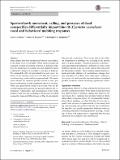Sparrowhawk movement, calling, and presence of dead conspecifics differentially impact blue tit (Cyanistes caeruleus) vocal and behavioral mobbing responses
Abstract
Many animals alter their anti-predator behavior in accordance to the threat level of a predator. While much research has examined variation in mobbing responses to different predators, few studies have investigated how anti-predator behavior is affected by changes in a predator’s own state or behavior. We examined the effect of sparrowhawk (Accipiter nisus) behavior on the mobbing response of wild blue tits (Cyanistes caeruleus) using robotic taxidermy sparrowhawks. We manipulated whether the simulated predator moved its head, produced vocalizations, or held a taxidermy blue tit in its talons. When any sparrowhawk model was present, blue tits decreased foraging and increased anti-predator behavior and vocalizations. Additionally, each manipulation of the model predator’s state (moving, vocalizing, or the presence of a dead conspecific) impacted different types of blue tit anti-predator behavior and vocalizations. These results indicate that different components of mobbing vary according to the specific state of a given predator—beyond its presence or absence—and suggest that each might play a different role in the overall mobbing response. Last, our results indicate that using more life-like predator stimuli—those featuring simple head movements and audio playback of vocalizations—changes how prey respond to the predator; these ‘robo-raptor’ models provide a powerful tool to provide increased realism in simulated predator encounters without sacrificing experimental control.
Citation
Carlson , N , Pargeter , H M & Templeton , C N 2017 , ' Sparrowhawk movement, calling, and presence of dead conspecifics differentially impact blue tit ( Cyanistes caeruleus ) vocal and behavioral mobbing responses ' , Behavioral Ecology and Sociobiology , vol. 71 , 133 . https://doi.org/10.1007/s00265-017-2361-x
Publication
Behavioral Ecology and Sociobiology
Status
Peer reviewed
ISSN
0340-5443Type
Journal article
Description
Funding: UK NERC (NE/J018694/1), Royal Society (RG2012R2), M.J. Murdock Charitable Trust (2014199), University of St Andrews 600th Year Scholarship, University of St Andrews St Leonard's Fee Scholarship.Collections
Items in the St Andrews Research Repository are protected by copyright, with all rights reserved, unless otherwise indicated.

